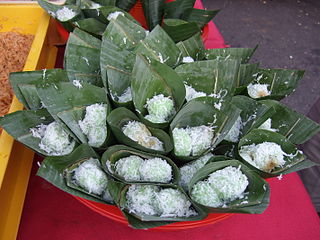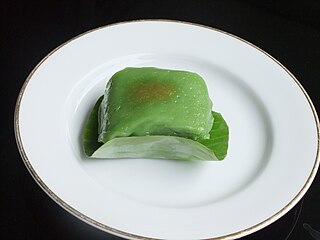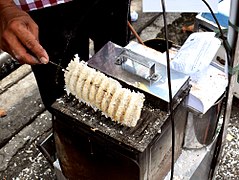
A pancake is a flat cake, often thin and round, prepared from a starch-based batter that may contain eggs, milk and butter and cooked on a hot surface such as a griddle or frying pan, often frying with oil or butter. It is a type of batter bread. Archaeological evidence suggests that pancakes were probably eaten in prehistoric societies.

Kuih are bite-sized snack or dessert foods commonly found in Southeast Asia and China. It is a fairly broad term which may include items that would be called cakes, cookies, dumplings, pudding, biscuits, or pastries in English and are usually made from rice or glutinous rice. In China, where the term originates from, kueh or koé (粿) in the Min Nan languages refers to snacks which are typically made from rice but can occasionally be made from other grains such as wheat. The term kuih is widely used in Malaysia, Brunei, and Singapore, kueh is used in Singapore and Indonesia, kue is used in Indonesia only, all three refer to sweet or savoury desserts.

A rice cake may be any kind of food item made from rice that has been shaped, condensed, or otherwise combined into a single object. A wide variety of rice cakes exist in many different cultures in which rice is eaten and are particularly prevalent in Korea and Japan. Common variations include cakes made with rice flour, those made from ground rice, and those made from whole grains of rice compressed together or combined with some other binding substance.

Kue is an Indonesian bite-sized snack or dessert food. Kue is a fairly broad term in Indonesian to describe a wide variety of snacks including cakes, cookies, fritters, pies, scones, and patisserie. Kue are made from a variety of ingredients in various forms; some are steamed, fried or baked. Kue are popular snacks in Indonesia, which has the largest variety of kue. Because of the countries' historical colonial ties, Koeé (kue) is also popular in the Netherlands.

Klepon or kelepon, also known outside Java as onde-onde, is a snack of sweet rice cake balls filled with molten palm sugar and coated in grated coconut. Of Javanese origin, the green-coloured glutinous rice balls are one of the popular traditional kue in Indonesian cuisine.

Kue kembang goyang or kuih loyang is an Indonesian cuisine and Malaysian cuisine flower-shaped traditional snack (kuih), associated with Betawi cuisine and Malay cuisine.

Betawi cuisine is rich, diverse and eclectic, in part because the Betawi people that create them were composed from numbers of regional immigrants that came from various places in the Indonesian archipelago, as well as Chinese, Indian, Arab, and European traders, visitors and immigrants that were attracted to the port city of Batavia since centuries ago.

Kue lapis is an Indonesian kue, or a traditional snack of steamed colourful layered soft rice flour pudding. In Indonesian lapis means "layers". This steamed layered sticky rice cake or pudding is quite popular in Indonesia, Suriname and can also be found in the Netherlands through their colonial links. Kue lapis is also very popular in neighbouring Malaysia, Singapore, and Brunei where it is called kuih lapis. Kue lapis was introduced by the Sino-Burmese to Lower Myanmar, where it is known as kway lapay (ကွေလာပေး) or kway lapaysa (ကွေလာပေးစ).

Kue bugis is Indonesian kue or traditional snack of soft glutinous rice flour cake, filled with sweet grated coconut. The name is suggested to be related to Bugis ethnic group of South Sulawesi as their traditional delicacy, and it is originated from Makassar. In Java the almost identical kue is called kue mendut. Kue bugis, together with kue lapis and nagasari are among popular kue or Indonesian traditional sweet snacks, commonly found in Indonesian traditional marketplace as jajan pasar.

Kue gapit is an Indonesian kue kering which originates from Cirebon, West Java. Generally made from tapioca flour, its name comes from the cooking process, in which it is grilled between iron molds like a waffle. The snack comes in a variety of shapes and flavors. Though it is a popular souvenir among visitors to Cirebon, residents of the region rarely eat it.

Kue ape or serabi Jakarta is a popular traditional kue pancake with soft and fluffy center surrounded with thin and crispy crepes, commonly found as a popular street food in Indonesia, especially in Jakarta and other major cities. It is also popularly known as kue cucur tipis, which is different from the thicker kue cucur, and colloquially known as kue tetek due to its shape that resembles a nipple. Because it is deemed inappropriate to say ‘tetek’, most Indonesians just say kue ape as in “what cake?”. It is also very similar to serabi Solo.

Dadar gulung is a popular traditional kue of sweet coconut pancake. It is often described as an Indonesian coconut pancake.

Palembangese cuisine is the cuisine of the Palembangese people of the city of Palembang in the South Sumatra province of Indonesia. It is the second most well-known cuisine from Sumatra after Padang.

Kue pukis or simply called Pukis is an Indonesian kue or traditional snack made of a wheat flour-based batter and cooked in a special mold pan. It is a commonly found snack in Indonesian traditional markets.

Kue pancong, kue pancung, bandros, gandos, or buroncong is an Indonesian kue or traditional snack made of a rice flour and coconut-based batter and cooked in a special mold pan. It is a commonly found snack in Indonesian traditional markets. Kue pancong is usually associated with Betawi cuisine of Jakarta, while bandros is often associated with Sundanese cuisine of Bandung city, and buroncong with Makassarese cuisine of Makassar, although all refer to the same coconut hot cake.

Indian Indonesian cuisine is characterized by the mixture of Indian cuisine with local Indonesian-style. This cuisine consists of adaptations of authentic dishes from India, as well as original creations inspired by the diverse food culture of Indonesia. Indian influence can be observed in Indonesia as early as the 4th century. Following the spread of Islam to Indonesia and trading, Muslim Indian as well as Arab influences made their way into Indonesian cuisine. Examples include Indian biryani, murtabak, curry and paratha that influenced Acehnese, Minangkabau, Malay, Palembangese, Betawi and Javanese cuisine.

Kue talam is an Indonesian kue or traditional steamed snack made of a rice flour, coconut milk and other ingredients in a mold pan called talam which means "tray" in Indonesian. The cake mold used to create kue talam are either larger rectangular aluminium tray or smaller singular cups made from ceramics, aluminium, melamine or plastic.

Kue bangkit is a small biscuit that made from sago starch of Malay origin, commonly found in Indonesia and Malaysia. This biscuit has various colours, ranging from white, yellowish to brown, depends on the additional ingredients.

Indo cuisine is a fusion cooking and cuisine tradition, mainly existing in Indonesia and the Netherlands, as well as Belgium, South Africa and Suriname. This cuisine characterized of fusion cuisine that consists of original Indonesian cuisine with Eurasian-influences—mainly Dutch, also Portuguese, Spanish, French and British—and vice versa. Nowaday, not only Indo people consume Indo cuisine, but also Indonesians and Dutch people.
























